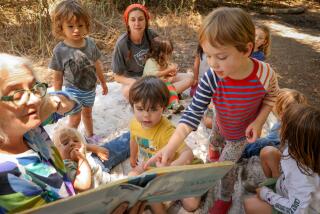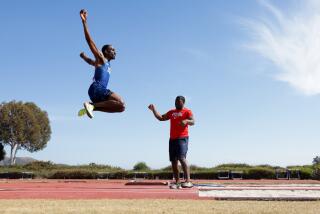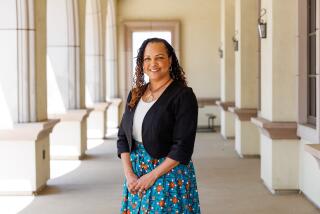Warming Up to Snow : Education: Blind and partially sighted preschoolers get a fun-filled introduction to something frosty and mysterious, and love it.
SANTA ANA — Gently prodded by her teacher, 3-year-old Amelia cautiously walked forward. She didn’t know what she was searching for. She just heard laughter and excited voices and wanted to investigate. She took two small steps then stumbled into the snow.
Friday morning, Amelia and her classmates at the Blind Children’s Learning Center in Santa Ana had their first encounter with snow.
Teachers at the center are always on the lookout for new experiences for their preschoolers. So when a local ice-skating school offered to give them a truckload of simulated snow, they had it dumped on the playground and set the children loose to explore.
“Many don’t know what snow is,” said Linn Morgan, director of community relations. “It’s really important to blind children that they experience what ‘real’ is so they know what things feel like.”
After sitting in the snow for a few moments, Amelia timidly touched the ground. She slowly grasped a handful and tasted it. She picked up another handful and patted it against her cheek. A few seconds later, she smiled.
Several feet away, 5-year-old Delia, with the aid of teacher Sharon Mitchael sat on a plastic trash can lid on the mound of cold stuff. Mitchael gently pushed the lid and Delia laughed as she sledded downhill. At the foot of the hill, she gingerly scooped up some snow, sniffed it, then begin to nibble on it.
“Does it taste good?” Mitchael asked.
Delia smiled, nodded, and yelled, “It’s cold!”
Delia, who lost her vision shortly after birth, epitomizes a success story for the center, her teachers maintain.
She was a shy child who would hang her head when she first enrolled. But under the guidance of the center’s staff, she now “talks all the time and asks questions about her environment,” Patty Salcedo said.
Delia is one of the center’s 38 students who either are blind or partially sighted. The privately funded center also accepts sighted children to be in its “reverse-mainstream” program designed to motivate blind and visually impaired children to interact with their sighted peers. In addition, the agency has an in-home program where its staff provides services to newborns diagnosed with vision problems. The center’s 10-member staff includes teachers, aides, an occupational therapist and a psychologist.
Many of the children do not like to be touched, she said. “They shy away or are simply frightened. It’s important that we get them beyond that so they can feel comfortable.”
As they advance through the program, the children are taught to interact and to be independent, educational director Gabrielle Hass said.
Seven preschoolers will graduate from the program next July, and although the teachers said they are proud to be a part of that accomplishment, they are sad at the thought of their students leaving.
“We’d keep them forever if we could,” said Mitchael. “Look at her playing in the snow,” she added, pointing to a pony-tailed, bespectacled girl scampering in the white stuff.
Five-year-old Lindsey is legally blind but is always ready to explore the unknown, her teachers said.
Friday, she not only sledded but helped a younger partially sighted friend build a snowman.
However, she didn’t take time to admire her work of art. Kneeling on the ground, she delicately gathered up some snow and kneaded it. Then, rubbing her palms together, she mischievously looked around.
“Oh, Sharon,” she said. And, when Mitchael turned around, she was hit by a well-aimed snow ball.






